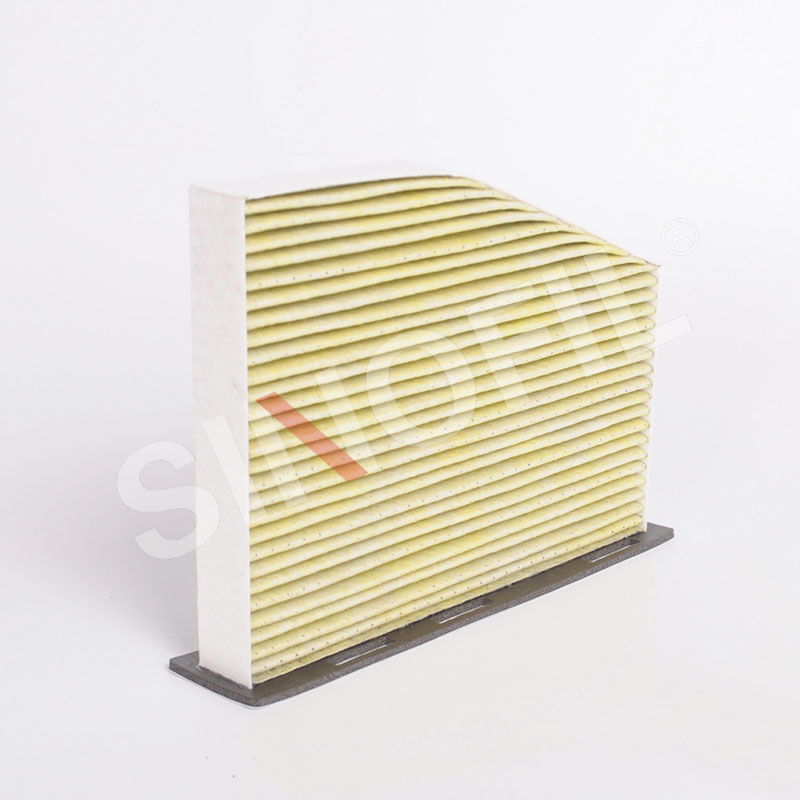Home / News / How should an activated carbon cabin air filter be designed to ensure a proper fit to the housing, prevent air bypass and ensure maximum filtration efficiency?
To ensure an activated carbon cabin air filter fits properly, prevents air bypass, and provides maximum filtration efficiency, the design should address several key factors:
Accurate Sizing and Shape:Precision Manufacturing: The filter should be manufactured to exact specifications to match the dimensions and shape of the cabin air filter housing. This includes the length, width, and depth of the filter.Custom Fit: The filter design should take into account the specific contours and mounting features of the vehicle's filter housing to ensure a snug fit.
Gasket and Seal Design:Gaskets and Seals: Incorporate gaskets or seals around the perimeter of the filter to create an airtight seal when installed. This prevents air from bypassing the filter and ensures that all air passing through the cabin air system is filtered.Seal Integrity: Use high-quality materials for gaskets and seals that can withstand temperature variations and aging without deteriorating or losing their sealing properties.
Frame and Structural Support:Rigid Frame: A sturdy frame or support structure within the filter helps maintain its shape and prevents deformation during installation or use. This rigidity helps ensure the filter stays in place and continues to fit properly over time.Reinforced Edges: Reinforce the edges of the filter to avoid any bending or warping, which could lead to gaps and reduced filtration efficiency.
Airflow Management:Optimized Airflow Design: Design the filter to allow for smooth and efficient airflow through the activated carbon layer. This involves ensuring that the filter medium is evenly distributed and that there are no obstructions that could impede air movement.Uniform Distribution: Ensure that the activated carbon is evenly distributed throughout the filter media to avoid areas of low filtration efficiency.

Quality of Activated Carbon:High-Quality Carbon: Use high-grade activated carbon with a large surface area and high adsorption capacity to maximize the filter's ability to remove pollutants and odors.Binding and Support: Properly bond the activated carbon to the filter media to prevent shedding or displacement during use.
Filter Media Composition:Multi-Layer Design: Consider a multi-layer design that combines activated carbon with other filtration media, such as particulate filters, to enhance overall filtration performance.Durable Media: Use durable materials for the filter media that can withstand environmental factors and maintain their effectiveness over time.
Testing and Quality Control:Rigorous Testing: Subject the filter to rigorous testing to ensure it meets performance standards for fit, filtration efficiency, and durability. This includes testing for air bypass, pressure drop, and pollutant removal.Quality Assurance: Implement strict quality control measures throughout the manufacturing process to ensure each filter meets the specified design criteria.
User-Friendly Design:Easy Installation: Design the filter for ease of installation and removal by the user. This includes clear labeling and instructions for proper installation and handling.Durability: Ensure that the filter can withstand regular handling and installation without compromising its integrity or filtration performance.
Compatibility:Vehicle-Specific Design: Ensure that the filter is designed to fit a wide range of vehicle models if applicable, or create vehicle-specific designs for a more tailored fit.Universal vs. Custom Fit: For universal filters, design them to be adaptable with adjustable elements to fit various filter housings securely.
Environmental Considerations:Eco-Friendly Materials: Use environmentally friendly materials for the filter frame and media where possible to reduce the ecological impact.Recyclability: Consider design features that facilitate the recycling of the filter components at the end of their life cycle.
By addressing these design aspects, an activated carbon cabin air filter can effectively fit into its housing, prevent air bypass, and provide high levels of filtration efficiency, contributing to better air quality inside the vehicle.



 English
English Español
Español











 ++86 183 3391 1399
++86 183 3391 1399


 +86 183 3391 1399
+86 183 3391 1399
 +86 187 3296 0060
+86 187 3296 0060 Wangshigong Village, Wei County, Xingtai City, Hebei Province, China
Wangshigong Village, Wei County, Xingtai City, Hebei Province, China
